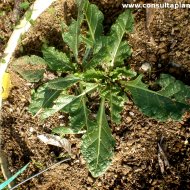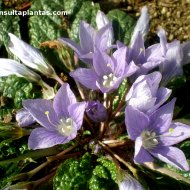Care of the plant Mandragora officinarum or Mandrake |
|
The genus Mandragora, family Solanaceae, includes 3 species of herbaceous plants native to Eurasia. The species are: Mandragora officinarum, Mandragora caulescens, Mandragora turcomanica. Common names: Mandrake, Autumn mandrake. This species is native to Europe. They are creeping herbaceous plants that reach 10 cm (3.93") in height and 30 cm (11.8") in diameter. The long, curious root looks like a split carrot reminiscent of a human body. The large, wavy, rosette-shaped leaves are dark green and oval in shape. The greenish-white or blue flowers appear in the center of the rosette. They bloom in late summer and early fall. They produce globular orange or red fruits. Mandrake is used in undergrowth, in borders, along walls and in deep pots for patios and terraces. Formerly it was used as a medicinal plant but it is very toxic. Mandragora officinarum needs semi-shade exposure avoiding direct sun in the central hours of the day. It resists frost well but is sensitive to intense heat. The soil can be a normal well-drained garden soil with 20% coarse sand and a little organic matter. Water regularly so the substrate never dries out completely. They do not resist drought. Fertilize with compost at the time of planting. Mandrake does not need pruning. Mandragora officinarum is a plant resistant to the usual pests and diseases. Autumn mandrake is propagated by division and from seeds sown in autumn or spring. |
Images of the plant Mandragora officinarum or Mandrake |
Find plants
Mandragora officinarum or Mandrake | Care and Growing
© 2026 FavThemes


